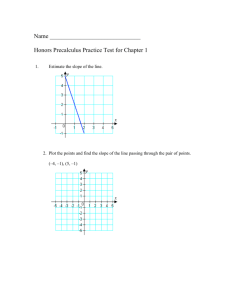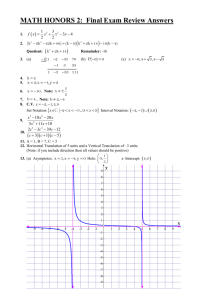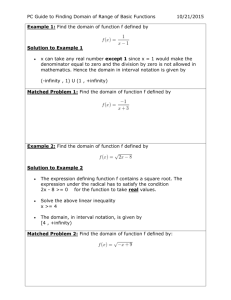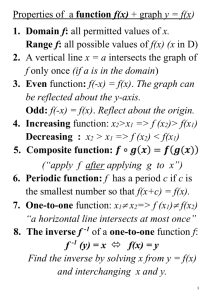AP Calculus - SectionF
advertisement
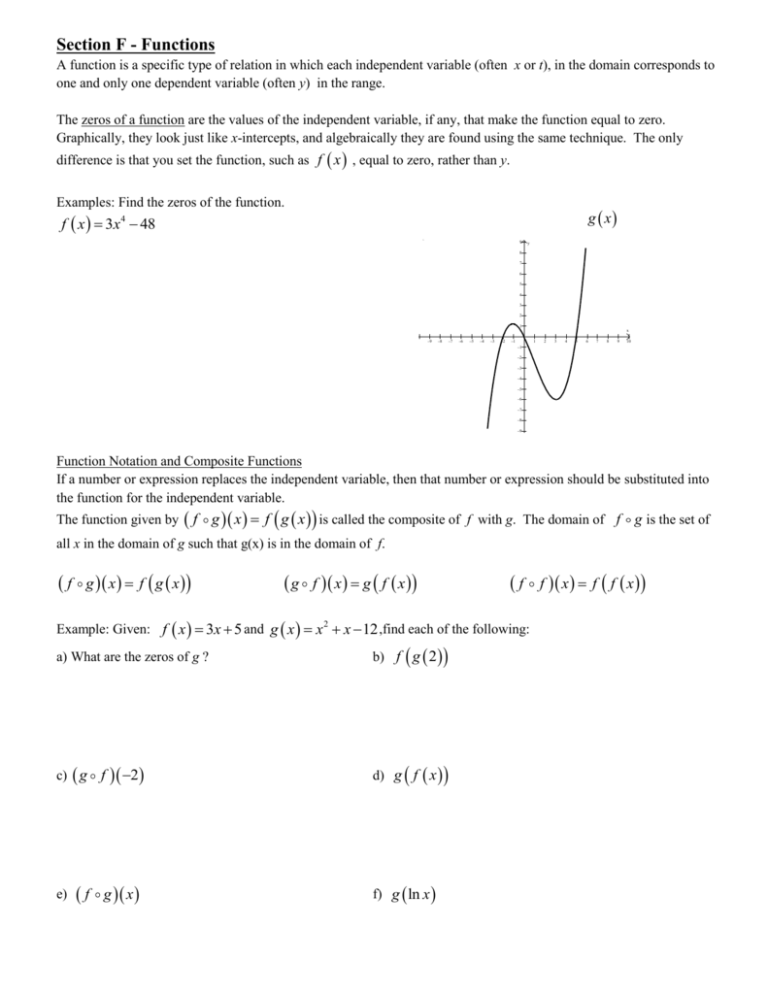
Section F - Functions A function is a specific type of relation in which each independent variable (often x or t), in the domain corresponds to one and only one dependent variable (often y) in the range. The zeros of a function are the values of the independent variable, if any, that make the function equal to zero. Graphically, they look just like x-intercepts, and algebraically they are found using the same technique. The only difference is that you set the function, such as f x , equal to zero, rather than y. Examples: Find the zeros of the function. g x f x 3x4 48 y x Function Notation and Composite Functions If a number or expression replaces the independent variable, then that number or expression should be substituted into the function for the independent variable. The function given by f g x f g x is called the composite of f with g. The domain of f g is the set of all x in the domain of g such that g(x) is in the domain of f. f g x f g x g f x g f x f Example: Given: f x 3x 5 and g x x 2 x 12 ,find each of the following: a) What are the zeros of g ? b) f g 2 c) g f d) g f x e) f 2 g x f) g ln x f x f f x Examples: Use the table below and h 0 3 , h 1 1 , h 3 0 to find the following: x -5 -3 -1 0 1 3 5 f x g x 12 5 9 3 7 0 5 -1 3 -3 1 -5 -2 -8 a) f g 1 b) h1 0 d) f g 1 5 e) f g g 3 c) h f 3 f) f 1 g h 0 Even and Odd Functions Even functions are symmetrical about the y-axis. To see if a function is even, replace x with -x, and see if expression is the same. y x, y x, y x Odd functions are symmetrical about the origin. To see if a function is odd, replace x with –x, and see if the expression is the opposite. y x, y x x, y Examples: Show whether the functions are even, odd, or neither. f ( x) x 2 x 2 4 x4 h( x ) 2 x 4 j x 2x3 4x Domain and Range The domain of a function is the set of values of the independent variable (often x or t) for which the function is defined. The range of a function is the set of values of the dependent variable (often y) that a function can return. In calculus, we will often write domains and ranges in interval notation. If the domain were -1< x ≤ 7 then in interval notation the domain would be (-1,7]. Notice that the left side has a ( because it does not include -1 but the right side includes 7 so we use a ]. When using interval notation we never use a [ or ] for infinity. To find the domain, look for restrictions on the independent variable. Common restrictions: 1) Denominators of fractions cannot be zero. 2) Expressions inside radicals (with an even root) must be greater than or equal to zero. 3) Expressions inside logarithms must be greater than zero. Examples: Find the domain of the following functions. f ( x) x5 2x h( x) ln 3 x g ( x) j x x 1 x x 12 2 x2 9x2 4 Inverse Functions f 1 (x) is the notation used to represent the inverse function of the function f (x) . Property 1 f ( f 1 (x)) x f 1 ( f (x)) x Property 2 1 The domain of f (x) is the range of f (x) . 1 The range of f (x) is the domain of f (x) . Property 3 1 If f (x) contains the point (a,b) then f (x) contains the point (b,a). This means the inverse functions are symmetrical about the line y x Existence of an Inverse Function A function has an inverse if it is strictly monotonic on its entire domain (always increasing or always decreasing) The horizontal line test: To have an inverse, the function must not cross any horizontal line more than once. This means it is one-to-one (For every y-value there is one and only one corresponding x-value.) Finding an Inverse Function 1) Let f (x) = y 2) Switch the x and y variables. 3) Solve for y. 1 4) Let y= f (x) Examples: Find the inverse of each function. f x 3x 2 x5 h( x) ln x 5 g ( x) x 2 1 j ( x) 2e x 4
